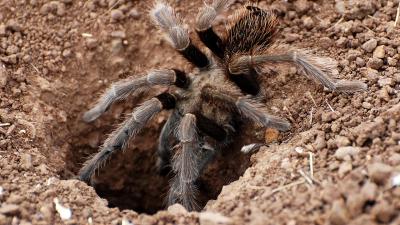In the open fields and grassy hills of Midpen preserves, a hairy courtship ritual takes place each autumn. August to October is mating season for the Bay Area blond tarantula (Aphonopelma iodius), when the ordinarily nocturnal eight-legged creatures brave daylight in search of a mate. A female tarantula will wait in her silk-lined burrow, while the males will wander far and wide (up to three-quarters of a mile!) to find her. Sadly, this often leads to male tarantulas being squished on roads and trails as they search for love.
Though tarantulas are large and look a bit scary, their venom is not dangerous to humans, and they will not bite unless provoked. They also have a unique defense mechanism: loosely attached barbed hairs on the back of their abdomen. When these small hairs are “flung” at a predator, they dig into mucous membranes and can cause breathing difficulty in small animals. For us humans, they may cause skin inflammation similar to irritation caused by fiberglass.



